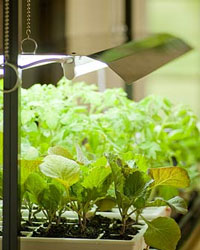





As a founding employee of Gardener's Supply, I wore many different hats over the years. Currently, I have my own company called Johnnie Brook Creative. The gardens around my home in Richmond, VT, include a large vegetable garden, seasonal greenhouse, cutting garden, perennial gardens, rock garden, shade garden, berry plantings, lots of container plants and a meadow garden. There's no place I'd rather be than in the garden.

Specially designed light stands make it easy to provide the intensity of light that seedlings require.
To get the right size bulb, look on the fixture (or the old bulbs) for the "T" (tube) size. Conventional "shop-light"-type fixtures usually fit T-12 bulbs. However, our new line of fixtures takes T-5 and T-8 bulbs, which are more narrow and more efficient. For more information, read Why Our Bulbs Are Better.
When starting seeds indoors, one of the most important factors is light. Sure, you’ll want to choose a good seedstarting mix and establish a good watering routine, but proper lighting is crucial for healthy, stocky seedlings. The good news is that artificial lights, when used correctly, can give seedlings all the light they need to thrive.
Here are the key points to consider when growing seedlings under lights:
Light Intensity: Seedlings require lots of bright light, and when they don’t receive enough of it they get tall and leggy. In most cases, even the sunniest windowsill will not provide the intensity of light they need. The best solution is to grow your seedlings under fluorescent lights.
Growing plants under lights, lets you control light intensity in two ways: the wattage of the bulb and how close the bulb is to the plant's foliage. Fluorescent bulbs are ideal for seedstarting because they give off very little heat. This means you can provide high light intensity by positioning the bulbs just 2-3″ above the foliage. Regular incandescent bulbs are not used for growing seedlings because they give off too much heat and can burn tender foliage.
As your seedlings grow, the fluorescent light fixture should be raised about once a week to maintain a 3-4″ distance between bulb and foliage. A light stand with one or more adjustable fixtures makes this task easy.
Duration of Light: Most vegetables are “long-day” plants, which mean they require 14 to 18 hours of sunlight (or artificial light) each day. A rest period is equally important for healthy growth, so be sure your seedlings also get at least eight hours of darkness. Using an automatic timer is the best way to ensure that the lights are on for the right amount of time each day.
Color of Light: Natural sunlight is the ideal light for starting seedlings, but with full-spectrum light bulbs, you can come pretty close. Full-spectrum fluorescent bulbs replicate approximately 94 percent of the solar spectrum. Recent innovations in fluorescent bulb technology have resulted in new-style bulbs that are lower in profile and higher in efficiency than standard fluorescent bulbs. That said, standard cool-white fluorescent bulbs will work just fine for starting seeds. To learn more about the benefits of full-spectrum light bulbs, read Why Our Bulbs are Better.
To learn more about seedstarting, including tips for planning and timing, fertilizing, temperature and humidity, thinning and hardening off, read How to Start Seeds.
Copyright © www.100flowers.win Botanic Garden All Rights Reserved